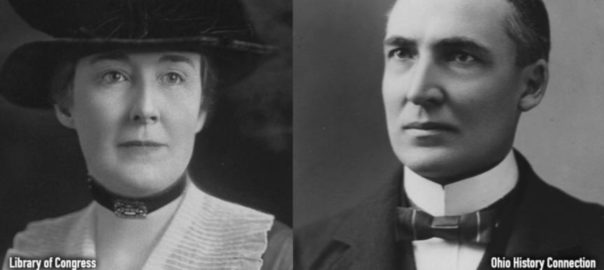I originally published this piece as a Facebook “note” in 2014. Facebook is discontinuing notes, so I am now moving it to American Pathos.
On Tuesday, the Library of Congress will release, to considerable fanfare, one of the most contested, yet somehow least known, presidential document collections in American history: the long-suppressed love letters of Warren G. Harding to his mistress, Carrie Phillips.
The letters have a complex history.
Jim and Carrie (Fulton) Phillips were neighbors of Warren and Florence Harding’s in the first decade of the twentieth century. The two couples became friends, even touring Europe together. In 1904, the Phillipses’ young son died. Warren had never particularly loved Florence, who was older than he, sickly, and something of a scold, and in the emotional aftermath of the child’s death he and Carrie fell in love. For several years, the friendship between the two couples continued, but eventually Florence caught on and shut Carrie out of her life. Warren, though, was an increasingly busy and important man, first in Ohio politics and then nationally, and he was always on the road, so the affair continued and deepened.
In the early 1910s, the Phillipses traveled to Germany, which was at the height of its power and glory. Carrie fell in love, to the point of obsession, with all things German and remained there for some time. Meanwhile, Warren was elected to the United States Senate from Ohio. Carrie returned to America, but her new love of German culture, and Warren’s position in the Senate, set the two up for a clash when World War I broke out in the summer of 1914. The United States struggled to remain neutral, but U.S.-German relations deteriorated quickly after mid-1915. Warren continued to pour out his heart to Carrie, but his passionate letters were tinged with near-panic as Carrie refused to moderate her outspoken pro-German sentiments. She even began to openly threaten Warren should he vote for a war declaration against her adopted homeland.
In April 1917, the United States declared war against Germany, and Warren, who voted for the war, soon realized that the Wilson administration’s intelligence agencies were investigating Carrie. Worse, there was much to investigate. Carrie and Jim’s daughter was openly courting the cousin of a German heiress who was a known spy. Federal agents arrested the heiress in a Chattanooga hotel room while she was plying her feminine charms to extract troop movement information from a young American soldier stationed at Fort Oglethorpe.
Despite all of this, Warren, and even Carrie, somehow stayed out of trouble, and they continued to see one another at times, but Carrie never recovered, emotionally, from Germany’s loss in the war. For the first weeks after the Armistice, most people assumed that former president Theodore Roosevelt would be the Republican nominee in 1920. Roosevelt died suddenly in January 1919, however, and Warren’s star began to rise in what was certain to be a Republican campaign cycle. Carrie did not want Warren to be president, and it is at that point that the letters begin to suggest that Carrie was blackmailing Warren. In 1920, the Phillipses took a tour around the world, allegedly financed by the Republican National Committee (there is some dispute on this point), and Warren was elected president in a popular and electoral landslide over James M. Cox.
There is little evidence of correspondence between Warren and Carrie after Harding assumed the presidency in March 1921. He died suddenly only two and a half years later. Carrie remained in Marion, Ohio, but became estranged from Jim, who took to the bottle. She was again investigated for disloyalty during World War II. By the mid 1950s Carrie was an eccentric recluse. Her home fell into disrepair and her dogs—German shepherds—were poorly cared for. Eventually she was placed in a retirement home. The lawyer in charge of her estate, Don Williamson, found a sealed closet, and in it a box of letters, nearly a thousand pages, from Warren G. Harding. The letters were scattered, disjointed, undated, and thus wildly confusing. They were also shot through with florid expressions of love, and some were sexually explicit.
For several years, rumors circulated around town that Williamson had the letters. By 1963, the Harding Memorial Association, a group of local relatives and notables in Marion, was preparing for the late president’s 1965 centennial. In conjunction with this, the Association was planning a 1964 transfer of all of its Harding documents to the Ohio Historical Society. In the midst of this, Francis Russell of Massachusetts, a writer, one of several who were planning anniversary biographies of the much-maligned Harding, arrived in Marion. In an old book about the 1920s, Russell had read that during the 1920 Harding campaign all the store fronts in Marion were decorated—all, that is, except the store owned by Jim Phillips. Russell wondered why and soon found out about the Phillips affair and the rumor that Williamson had the letters. Russell tracked Williamson down and saw the documents himself, and that is when the great legal drama began. Russell convinced Williamson to transfer the letters to the Ohio Historical Society. Williamson agreed, and the cat was out of the bag. This set up a fight between Kenneth Duckett, an archivist at OHS, who genuinely wanted to preserve the letters for history; the OHS itself, which, as it turned out (or so Russell alleged) was something of a political arm of the Ohio Republican Party rather than a traditional historical depository; the Harding heirs, who wanted to suppress or destroy the letters; Russell, who wanted to be the first to use them; and American Heritage, to which Russell was a contributor.
Eventually, an easily manipulated state judge, relying on a highly questionable interpretation of copyright law, transferred the letters to the Harding Memorial Association. Duckett, however, had already made several microfilm copies, once actually having a fistfight at the copier when an OHS official tried to stop him, and had secreted the copies at various places around the country. Russell managed to get a a copy to American Heritage, but a court order forbade anyone to use the letters for any reason. Russell became so frustrated that, in 1968, he published his biography, The Shadow of Blooming Grove: Warren G. Harding in his Times, with long rows of hyphens replacing the alphabet characters of the Harding letters. In the end, a later court protected the letters by transferring them to the Library of Congress, where they were to remain under seal until July 2014, fifty years after the controversy began.
And here we are.
Despite many efforts at suppression and delay, the letters were not completely sealed. Russell had made notes in 1963, and a few stray but incomplete copies remained. In 2009, Cleveland attorney James Robenalt, whom I met first in 2011 and again last week, published The Harding Affair: Love and Espionage During the Great War, the only real study ever done of the incomplete letters. Robenalt believes, and I agree, that the letters, contrary to the long assessment of historians, show a Harding who was intelligent, hard-working, engaged, and scrupulously patriotic. Robenalt is calling for a professional reassessment of Harding and his place in history, and I support that effort. That is why I am now associated with the Warren G. Harding Symposium in Marion, and why I have traveled to that event three out of the last four years.
If you find this topic interesting, I urge you to pay attention to the news out of the Library of Congress on Tuesday. However, I would not expect too much in the way of serious treatment of the letters. The media will focus on sex and pet names and the like, and there will be little real analysis. Current politics will also come into play, as there has always been a Progressive political bias among professional historians against the three Republican presidents who served between Wilson and Franklin Roosevelt.
You may want to read Robenalt’s book, The Harding Affair: Love and Espionage During the Great War, which is readily available. You can also consult Robenalt’s web site, www.thehardingaffair.com [2020 note: the link is now dead]. Next year will be the 150th anniversary of Harding’s birth, so that, in conjunction with the release of the letters, will probably lead to a spate of new books.
As for me, you know that I live for this kind of thing, so I welcome any discussion of it on Facebook. Thanks for listening.
—Kevin Brewer, July 27, 2014


